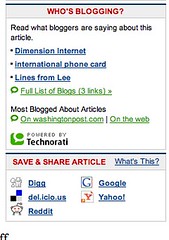Earlier today I saw an article called “A Messy Age for Music” about digital music on the Washington Post site. It was part of a package the Post put together on the iPod’s 5th birthday.
I thought the article was pretty informative, but just took issue with a quote that essentially equated the iPod with Betamax or 8-Track tapes. Maybe it’s just that we’re an eight-iPod family that makes it personal for me, but I just believe that with this week’s announcement that Apple sold 8.73 million iPods in the last quarter, and bringing the cumulative total to more than 67.6 million, it’s pretty unlikely that Apple’s AAC format is going to become obsolete and unplayable.
I searched the web to find how many total 8-track units had been sold, and couldn’t find a figure. Anybody have a number on that? I’m betting it was significantly less than 67 million, and that the critical mass for the iPod format will keep it from becoming obsolete.
So I blogged about it, and linked back to not only that article, but all of the articles in the series.
Then, as I was reviewing traffic to my blog tonight, I realized something interesting: several readers had gotten to my post through the Washington Post site. When I clicked back I discovered this:

Since this is powered by Technorati, I assume it’s important that you “ping” Techhnorati in order to be included in the listings. I have used the free service pingoat to ping Technorati and several other blog engines.
I had seen and heard some articles about how the Post “gets” the conversation of the blogosphere. It was neat to experience it first-hand, and to write a letter to the editor that was essentially published instantly.
 Technorati: Technorati, Washington Post, iPod, Blogging, Pingoat, Betamax, 8-Track
Technorati: Technorati, Washington Post, iPod, Blogging, Pingoat, Betamax, 8-Track

